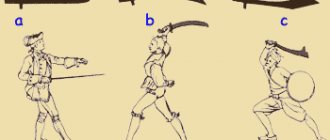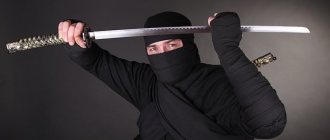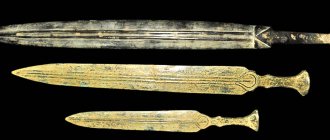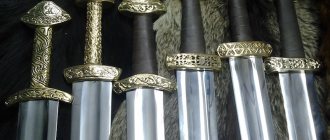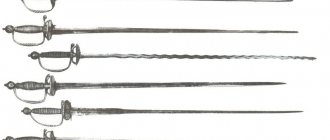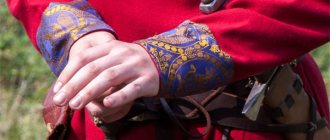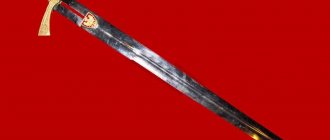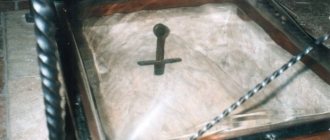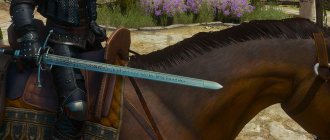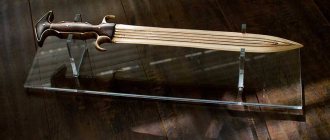The term "kopis" (from the ancient Greek word meaning "to cut, to strike") (there is an alternative version of the origin from the ancient Egyptian term "khopesh" for a cutting sword) in Ancient Greece meant a heavy knife with a blade curved forward, mainly used for cutting meat, slaughtering animals, or for sacrificing them, or it meant a sword with a similar shape, with a one-sided sharpening, designed for cutting and piercing blows.
Falcata sword, history of weapons, description and application
In the old days, curved swords were used by different peoples. The type of sword - falcata, was widespread in pre-Roman Hispania, the modern states of Spain and Portugal. Subsequently, mention of the sword occurs almost everywhere. The very successful shape of the blade was loved by many.
Wrong name
No one can name the exact name of the blade. But in more modern history of the 19th century, with the light hand of historian Fernando Fulgosio in 1872, the name Falcata came from the name Ensis Falcatus , which means “sickle-shaped sword”.
Apparently, there was confusion about the Spanish name falcatus, which means a feminine sword. A translator of Latin texts considered this word a proper name , which quickly gained popularity.
Origin of the sword
There is a version that the falcata sword comes from Iberia, that is, from the territory of the Iberian Peninsula. It was considered the original weapon of the Iberians. But one should take into account the enormous influence of the Greeks in the Mediterranean.
Ancient Iberian falcata.
Found Iberian falcata sword from the 3rd-4th centuries BC. had:
| Parameter | Meaning |
| Total length. | 532 mm. |
| Blade length. | 432 mm. |
| Blade width is maximum. | 67 mm. |
| The blade width is minimal. | 21 mm. |
| Product weight. | 473 grams. |
According to another, more confident version, the falcata came from the ancient Egyptian sword khopesh. Its appearance dates back to 1600 BC. and have been in use for over 300 years. For many years, the falcata was the main sword of the Greek Macedonians, Iberians and Romans.
But over time it was supplanted by other blades, the gladius and spatha.
According to another version, falcata developed parallel to the Greek kopis, and was not its descendant. Similar swords came from sickle-shaped knives. Falcata was also used for ritual purposes on the Iberian Peninsula by the Celts.
Shape and Description
The blade of the weapon was about 70 cm long; it was made first of bronze and then of iron. Its parameters were as follows:
- the blade narrowed to half the blade, but when it reached the tip, it expanded;
- the blade belongs to the swords with a reverse bend; it was sharpened from the concave side;
- The sword had practically no guard; a small protrusion in the form of a beak slightly covered the hand;
- the top of the handle also had a small protrusion, which was sometimes connected by a small bridge to the guard. This formed a small brace to cover the fingers;
- weapons were made using forging; there were no separate elements. This means they crafted the entire product.
The quality of the iron from which the falcatas were made was of a high level. Before forging the product, the iron plate was buried for 2-3 years, corrosion ate away the weakest points. And only then was the sword made.
There are mentions by historians Philo and Diodorus of how the quality of the sword was checked. The blade was placed flat in the middle on the head, and the tip and handle were bent down to the shoulders. After this procedure, the falcata completely restored its shape.
An analysis of the swords found shows that the weapon was forged from three strips of varying degrees of hardness. It appears that a cold forging method was used. In fact, the steel often turns out to be high-carbon, and the core of the blade is made of softer iron. This achieves high flexibility of the blade.
Examples of weapons.
Application of falcata
The center of gravity of the falcata is shifted to the tip, this allows it to perform strong chopping blows, like an ax. The lack of a full guard is also explained by its shape. The weapon did not slip from the hand onto the blade. And the beak-shaped guard and pommel simply helped to hold the falcata.
The reverse stroke of the blade, due to its bending, produced a cutting movement. This form of the product does not require the use of force for cutting. The sharp end of the blade made it possible to perform piercing blows. There were certain inconveniences, but having adjusted, the warriors achieved success in handling weapons.
Zulfiqar
The history of the sword, which first belonged to the Prophet Muhammad, and then to the fourth righteous caliph Ali, is very confusing. Today, anyone can see the sword, called Zulfikar, in the Topkapi Palace in Istanbul. The problem is that it is completely different from the numerous descriptions of this blade. The legendary Zulfikar was credited with many magical properties. For example, outside of combat it could be thrown up and left hanging in the air. Or the fact that Ali received it from the Archangel Gabriel (Jibrail) himself. In the Middle Ages, all these legends were believed, and the cry “There is no hero except Ali, there is no sword except Zulfiqar!” actively used by warriors of Islam. From the legends came the belief that Zulfikar’s blade was forked. In imitation of this, medieval eastern gunsmiths mastered the production of swords with two blades, which were called zulfikars. However, the sword exhibited in Istanbul has a regular blade, only decorated with wavy lines. Whether it belonged to the Prophet Muhammad is not known for certain (many Muslims believe that the real magical Zulfiqar is hidden in a secret place), but it definitely dates back to the 7th century and took part in the great battles of the era of the formation of the Arab Caliphate. Then, until the beginning of the 20th century, this particular blade was used in the ceremony of “taqlidi safe” (girdling with a sword) of the sultans of the Ottoman Empire. This is an analogue of a European coronation. Now Zulfiqar is revered as one of the shrines of Islam.
Greek kopis sword and its features
Curved swords were used by different peoples, in different years and for different purposes. The only difference was their names. One of them is the ancient Egyptian khopesh, which clearly comes from the sickle.
The word khopesh in Greek means “to cut or cut off.” But today it is customary to call it kopis in English.
The history of the origin of the sword and its use
The experience of the ancient Greeks told them that a forward-curved blade was most convenient for mounted warriors. Straight swords were used by infantry.
The great ancient writer and commander Xenophon recommended the use of kopis for cavalry, since from the height of the horse’s back a slashing blow is more reliable than a piercing blow.
There is a version that the kopis sword was borrowed by the Greeks from the Persians in the 6th century BC. Herodotus in his works mentions such weapons among the Persians. Sometimes during excavations, specimens with a straight back side of the blade are discovered; such a kopis resembles a classic machete.
Application example.
The sword was very popular in Iberia, so much so that it was made a national weapon. It appeared there thanks to merchants in the 4th-5th centuries BC. The Iberian copis was borrowed by Roman soldiers after the war with Hannibal. And it was called "gladius hispanicus", which meant Spanish sword.
Weapon characteristics
The reverse-curved shape distributed the center of gravity closer to the tip. This made it possible to deliver slashing blows. But piercing movements were also quite suitable for weapons. The narrow blade near the hilt expanded towards the tip.
| Parameter | Length |
| early examples of a one-handed sword reached the length of: | 65 cm. |
| later Macedonian wares were shorter: | 45 cm. |
Comparisons are often made between the kopis and the Iberian falcata and with the later Nepalese kukri. There is also a parallel with the Greek mahaira.
Historians cannot reliably answer the classification of products. But there is an opinion that swords are divided according to the presence of forward curvature of the blade. The presence of this classifies the weapon as a copis.
Followers of the Blade
The conquests of Alexander the Great throughout Asia contributed to the widespread spread of kopis. Many products are discovered in India. There are opinions that:
- The Nepalese kukri, which has survived to this day, is considered a direct descendant of the Greek kopis;
- There are cautious statements from researchers that the Ottoman scimitar is also a distant relative of the kopis.
But the centuries-old difference in the distribution of yatogan and kopis gives many reasons to believe that this is just speculation.
Descendants of the Greek Kopis.
Joyeuse
The name of this sword means "Joyful". It is believed that it belonged to Charlemagne, one of the largest military and political figures of the Middle Ages. In the 8th and 9th centuries, Charles waged continuous wars, uniting European lands, and in 800 he declared himself Emperor of the West. The Joyeuse sword is described in the famous poem “The Song of Roland”. There, miraculous properties are attributed to it - supposedly the blade can change color, and a fragment of the spear of Longinus is inserted into its hilt. The same one with which the Roman centurion Longinus pierced the crucified Christ. It is not surprising that the emperor valued Zhu-ayoz extremely. They say that one day the sword was lost on the battlefield. One of the knights found him and returned him to the emperor. In gratitude, he became lord of the surrounding lands and received a new surname - Joyeuse. The nearby city was also named. The town still stands in southeastern France near Lyon. And the noble family of Viscounts (later Dukes) de Joyeuse played a significant role in the history of the country. Since the 13th century, Joyeuse became one of the state regalia of France and was used during the coronation of new monarchs. These days, the famous sword is on display in the Louvre. However, research has shown that its pommel was made in the 10th-11th centuries, the decorations on the crosshair - around the 12th, and the hilt itself - in the 13th or 14th centuries. And only the blade can claim to date back to the reign of Charlemagne. However, many doubt this too.
Mahaira sword, description and application
For a large knife, terms such as makhe - battle or makhesthai - fight are applied. Both words are of ancient Greek origin. In ancient writings, the word "mahaira" refers to any blade used in battle. In addition to a saber or sword, it can also be a long knife.
Among the Hellenes, the word makhaira itself meant a single-bladed weapon. Such products include:
- meat cutting knives;
- utility knife;
- even items for sacrifices.
The history of the blade
The mahaira appeared as a military weapon in the 6th-5th centuries BC.
Opinions
According to archaeologist Anton Dedyulkin.
The weapon disappears after the Roman conquest of Greece.
According to Plutarch.
Mohaira was used by Alexander the Great.
The Hellenistic period of ancient Greece, after the conquest of Xander the Great, was the full dawn of the mahaira sword.
Sizes and shapes
Modern scientists and archaeologists classify mahaira and kopis as several types of cutting weapons. Differences are observed only in the degree of curvature of the blade.
Weapons with a deeper curve are referred to as mahaira. They armed heavy cavalry with such swords.
Is the difference between makhaira and kopis clear?
Yes, it’s clear No, it’s not clear
The Persians used mahaira for 400 years. In comparison with the kopis, the mahaira, in addition to the larger bending angle of the blade, was significantly longer and reached 70 cm. The large dimensions provide a lot of inconvenience for fighting in formation. The blade of the sword was sharpened on one side, and the back was thickened for strength:
- the first third of the blade was narrow, 5 cm wide;
- then the sword thickened to 10 cm;
- towards the end of the blade a sharp toe was formed, lowered slightly downwards; part of it sank strongly downwards in relation to the longitudinal axis. This resulted in a bend, which is a distinctive feature of the blade.
Examples of the Mahaira sword.
Previous
Do-it-yourself bladed sword from 5 materials with step-by-step manufacturing instructions
Next
Bladed How much does a two-handed sword weigh: delving into history. 5 most famous two-handed swords
About the history of chicnueda
According to weapons historians, the appearance of the cinqueda is explained by the fashion trend of the time, which consisted of increased interest in classical ancient culture.
To a certain extent, proof of this version is the unique design of the handle, which is reminiscent of products from the Etruscan and ancient Greek eras. In the British Museum there is an artifact dating back to the 3rd century BC and being the only real analogue of the cinqueda. This dagger was found in southern Europe. The shape of its blade is exactly like the blade of the described Italian bladed weapon dating back to the Renaissance. It’s amazing that this dagger and the cinqueuda are separated by as many as 18 centuries! The short life of this defensive weapon is explained by the fact that in the second half of the 16th century the cinqueuda was replaced by swords and daggers. The former were loved by the nobles, and the latter were widespread among ordinary people. But the cinqueda was not immediately forgotten - its comfortable hilts were highly appreciated several centuries later, when they began to be used to make classic swords.
Bulli - fanfare from the outskirts
But not only bandits were famous throughout Italy as inveterate lovers of knives. Bullies were much more popular among the people - an interesting subculture that formed on the outskirts of cities and in slums, a kind of mixture of English fashionable dandies and our modern gopniks.
Despite widespread poverty, they tried to dress smartly, play cards and lead a riotous life. Aggressive and reckless behavior was part of their style and way of life, which, in the presence of knives, regularly led to murder.
However, their fights were not just drunken brawls. Most often, they had all the features of a duel - a challenge to a fight, seconds, and other attributes. The fact that this took place in the slums, and the opponents cut each other's guts out with knives and not noble swords, did not matter. Group massacres also occurred frequently.
Japanese swords[edit]
- Tsurugi (ken) is the same Chinese jian, a straight one-handed sword. It could represent either jian itself, imported from China, or its home-grown likeness. Existed until the 10th century AD. e.
- The tachi was a long, curved sword designed for cavalry that preceded the katana and for a time competed with it. Carried with the blade down, like a saber.
- The katana (the same hieroglyph as the Chinese Tao) replaced the tati by the 16th century. It is worn with the blade up, like a checker, more straight, designed for foot fencing. Only a katana, strictly speaking, is not a sword, but a SABER.
- Wakizashi is a short sword, up to 60 centimeters long. It was a common people's sword, allowed to be worn by non-samurai. Best known for being worn by samurai as a pair to a katana. If a person has only wakizashi, he is a commoner; if he has wakizashi and a katana, he is a samurai.
- Tanto is a knife or dagger made using the same blacksmithing technique as the katana and wakizashi. It is notable for the fact that it was at first called a katana; Then the word “katana” was divided into “koshigatana” (dagger) and “uchigatana” (sword). And then it was the uchigatana that began to be abbreviated as simply a katana.
- The naginata is a polearm resembling a glaive, which, however, was considered a type of long-handled sword.
- Bisento is also a glaive, but with a wide, heavy blade, similar to the Chinese da-dao. Unlike the naginata, due to its weight, it was a more significantly rare weapon requiring great physical strength.
- Shin-gunto is a 20th century officer's saber, shaped like a tachi, but produced industrially.
- Shirasaya is the Japanese answer to the European cane sword! Derived from the method of storing the blades of Japanese swords - a simple wooden case made of unvarnished magnolia, protecting the sword from dampness. It looks like a straight or slightly curved stick that serves as a sheath for a katana, chokuto or wakizashi blade. Outwardly, it resembled a training bokken sword, and therefore allowed you to calmly walk down the street with a prohibited weapon.
conclusions
It can be concluded that bronze swords of antiquity were made at a high level, given the underdevelopment of the technological process. In addition to their combat purpose, many swords were works of art, thanks to the efforts of the craftsmen. Each type of sword for its time met all combat requirements, to one degree or another.
Naturally, the weapon was gradually improved, and efforts were made to minimize its shortcomings. Having gone through centuries of evolution, ancient bronze swords became the best weapons of their era, until it gave way to the Iron Age and a new page began in the history of edged weapons.

